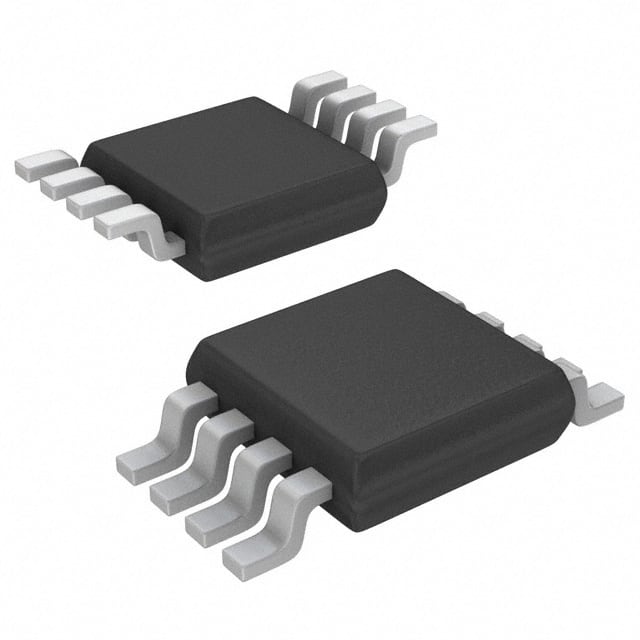X9317ZM8I
Product Overview
- Category: Integrated Circuit (IC)
- Use: Digital Potentiometer
- Characteristics: Non-volatile, 100 Taps, I2C Interface
- Package: 8-pin SOIC (Small Outline Integrated Circuit)
- Essence: X9317ZM8I is a digital potentiometer IC that provides a non-volatile solution for controlling resistance in various electronic circuits.
- Packaging/Quantity: Available in reels of 2500 units.
Specifications
- Resolution: 100 Taps
- Resistance Range: 10kΩ
- End-to-End Resistance Tolerance: ±20%
- Supply Voltage: 2.7V to 5.5V
- Interface: I2C (Inter-Integrated Circuit)
- Operating Temperature Range: -40°C to +85°C
Detailed Pin Configuration
The X9317ZM8I IC has the following pin configuration:
- VCC: Supply Voltage
- SDA: Serial Data Input/Output (I2C)
- SCL: Serial Clock Input (I2C)
- WP: Write Protect (Optional)
- H: Terminal A Connection
- W: Wiper Terminal Connection
- L: Terminal B Connection
- GND: Ground
Functional Features
- Non-volatile memory allows the IC to retain its settings even when power is removed.
- Provides precise and accurate resistance control with 100 tap points.
- I2C interface enables easy integration into digital systems.
- Low power consumption for energy-efficient applications.
- Write protect feature (WP) prevents accidental changes to the resistance settings.
Advantages and Disadvantages
Advantages
- Non-volatile memory ensures resistance settings are retained.
- Precise resistance control with 100 tap points.
- Easy integration into digital systems with I2C interface.
- Low power consumption for energy-efficient designs.
Disadvantages
- Limited resistance range of 10kΩ.
- End-to-end resistance tolerance of ±20% may not be suitable for highly precise applications.
Working Principles
The X9317ZM8I is based on the concept of a digital potentiometer. It consists of a resistive ladder network and a wiper that moves along the ladder, effectively changing the resistance between the wiper terminal (W) and the two end terminals (H and L). The position of the wiper determines the resistance value.
The IC utilizes non-volatile memory to store the wiper position, allowing it to retain the resistance setting even when power is removed. This feature ensures that the desired resistance value is maintained upon power-up.
Detailed Application Field Plans
The X9317ZM8I finds applications in various electronic systems where precise resistance control is required. Some potential application fields include:
- Audio Equipment: Volume control circuits, equalizers, and tone control circuits.
- Industrial Control Systems: Variable gain amplifiers, motor speed control, and sensor calibration.
- Test and Measurement Instruments: Programmable attenuators, signal generators, and waveform synthesis.
- Communication Systems: RF signal path adjustment, impedance matching circuits, and filter tuning.
Detailed and Complete Alternative Models
- X9C103S: 10kΩ Digital Potentiometer, 100 Taps, SPI Interface, 8-pin SOIC package.
- MCP401X: 10kΩ Digital Potentiometer, 256 Taps, I2C Interface, 8-pin SOIC package.
- AD8403: 10kΩ Digital Potentiometer, 256 Taps, SPI Interface, 8-pin SOIC package.
These alternative models offer similar functionality and can be considered as alternatives to the X9317ZM8I based on specific requirements and system compatibility.
In conclusion, the X9317ZM8I is a digital potentiometer IC that provides precise resistance control in various electronic applications. Its non-volatile memory, I2C interface, and compact package make it suitable for a wide range of systems. However, its limited resistance range and tolerance should be considered when selecting this IC for highly precise applications.
Senaraikan 10 soalan dan jawapan biasa yang berkaitan dengan aplikasi X9317ZM8I dalam penyelesaian teknikal
Sure! Here are 10 common questions and answers related to the application of X9317ZM8I in technical solutions:
Q: What is X9317ZM8I? A: X9317ZM8I is a digital potentiometer integrated circuit (IC) that can be used to digitally control resistance in various technical applications.
Q: How does X9317ZM8I work? A: X9317ZM8I works by using digital signals to adjust the resistance value, allowing for precise control over the circuit's characteristics.
Q: What are the key features of X9317ZM8I? A: Some key features of X9317ZM8I include non-volatile memory, low power consumption, wide operating voltage range, and small package size.
Q: In which technical applications can X9317ZM8I be used? A: X9317ZM8I can be used in various applications such as audio equipment, instrumentation, industrial control systems, and communication devices.
Q: Can X9317ZM8I replace traditional mechanical potentiometers? A: Yes, X9317ZM8I can be a suitable replacement for mechanical potentiometers as it offers greater precision, reliability, and flexibility.
Q: How do I interface with X9317ZM8I? A: X9317ZM8I can be easily interfaced with microcontrollers or other digital control systems using standard communication protocols like I2C or SPI.
Q: Can X9317ZM8I be used in high-temperature environments? A: X9317ZM8I has a specified operating temperature range, typically up to 85°C, so it may not be suitable for extremely high-temperature applications.
Q: Is X9317ZM8I resistant to electrical noise? A: X9317ZM8I has built-in noise filtering mechanisms, but additional precautions like proper grounding and shielding should be taken to minimize noise interference.
Q: Can X9317ZM8I be used in battery-powered devices? A: Yes, X9317ZM8I is designed to operate with low power consumption, making it suitable for battery-powered devices where energy efficiency is crucial.
Q: Are there any application notes or reference designs available for X9317ZM8I? A: Yes, the manufacturer of X9317ZM8I typically provides application notes, datasheets, and reference designs that can help guide the implementation of the IC in various technical solutions.
Please note that the answers provided here are general and may vary depending on specific requirements and use cases. It's always recommended to refer to the official documentation and consult with experts for accurate information.


